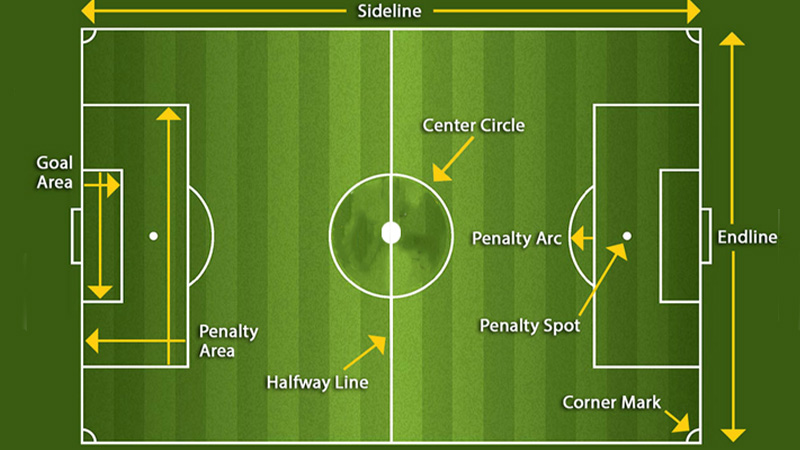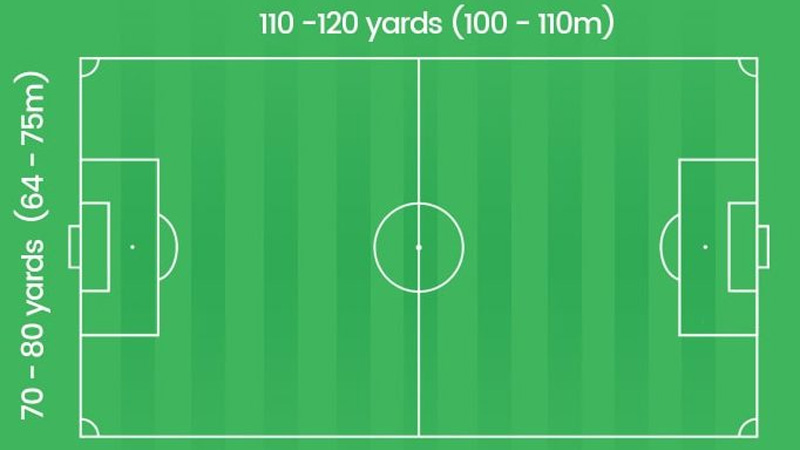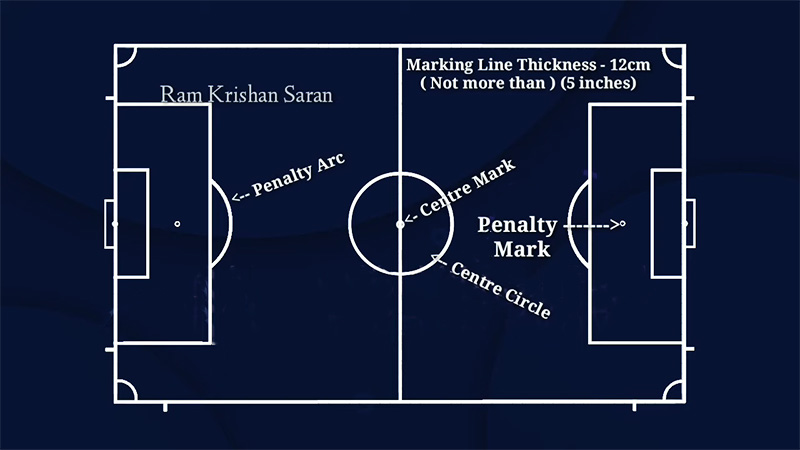Soccer, also known as football in many parts of the world, is a sport loved and cherished by millions of fans across the globe. While many spectators and players may be familiar with the fundamental rules of the game, there are specific aspects, such as the “endline,” that might require a closer look.
In this article, we delve into what is endline in soccer and its significance in the game. The endline in soccer serves as a fundamental boundary that defines the area where goals are scored. It plays a pivotal role in determining when the ball is out of bounds and how the play will be restarted.
The accuracy and integrity of goal decisions have been further enhanced through the integration of goal-line technology. Understanding the significance of the endline is essential for both players and spectators, as it clarifies critical aspects of the beautiful game of soccer.
What Is Endline in Soccer?
The endline, often referred to as the goal line, is a critical boundary that defines the vertical boundary of the soccer field. It extends between the two goalposts and stretches the entire width of the pitch.
One of the main objectives of the game is to score goals, and the endline plays a crucial role in determining whether a goal has been successfully scored or not.
The Function of the Endline
The primary function of the endline in soccer is to outline the area within which a goal is scored. When the ball fully crosses the endline and enters the goal, a goal is awarded to the team that managed to get the ball across the line. Conversely, if the ball does not fully cross the endline, no goal is given, and play continues.
The endline also serves as a reference point for other decisions made by the match officials during the game. For instance, if a player is deemed to have committed a foul or the ball goes out of play, the positioning of the ball concerning the endline determines how play will resume.
What Are the End Line Rules?

Soutce: soccerdrive
The end line rules in soccer are essential for determining goals, restarts, and out-of-play situations. Here are the key end line rules in soccer:
Scoring Goals
The primary purpose of the end line is to determine when a goal is scored. For a goal to be valid, the entire ball must completely cross over the end line and enter the goal.
It must pass between the goalposts and beneath the crossbar. If any part of the ball is still touching the line or hovering above it, the goal does not count.
Restarting Play
When the ball goes out of play over one of the end lines, play is temporarily stopped, and the method of restarting the game depends on which team touched the ball last:
- Goal Kick: If the ball was last touched by an attacking player and went out of bounds over the defending team’s end line, a goal kick is awarded to the defending team. The goalkeeper takes the goal kick from inside the six-yard box. Opposing players must be outside the penalty area until the ball is in play.
- Corner Kick: If the ball was last touched by a defending player and went out of bounds over their own end line, a corner kick is awarded to the attacking team. The attacking player takes the corner kick from the corner arc nearest to where the ball went out of bounds.
Goal-line Technology
In some high-level competitions, goal-line technology is employed to provide more accurate decisions on whether a goal has been scored.
This technology uses cameras and sensors to determine whether the entire ball has crossed the goal line. It aids the match officials in making crucial goal decisions quickly and with high precision.
Offside Decisions
While the end line is not directly involved in offside decisions, it plays a role in determining whether a player is in an offside position.
To be considered offside, a player must be nearer to the opponent’s goal line than both the ball and the second-to-last defender (usually the last outfield player, excluding the goalkeeper) when the ball is played to them. The position of the end line can help the assistant referee make this judgment accurately.
Understanding and adhering to the end line rules is crucial for players, coaches, and referees to ensure fair play and maintain the integrity of the game of soccer. These rules ensure that goals are correctly awarded, restarts are handled appropriately, and offside decisions are made with precision.
Soccer Field Dimensions

Source: soccerhandbook
The dimensions of a soccer field can vary depending on the level of play and the governing body’s regulations. However, I will provide you with the typical dimensions for a full-size soccer field used in international matches:
Length
The length of the field, often referred to as the touchline, is usually between 100 meters (approximately 328 feet) and 110 meters (approximately 360 feet).
Width
The width of the field, commonly known as the goal line, is typically between 64 meters (approximately 210 feet) and 75 meters (approximately 246 feet).
Penalty Area
The penalty area, also known as the 18-yard box, is located at each end of the field. It extends 16.5 meters (approximately 54 feet) from the goal line into the field and is 40.3 meters (approximately 132 feet) wide.
Goal Area
Inside the penalty area, there is a smaller rectangular area known as the goal area or 6-yard box. It extends 5.5 meters (approximately 18 feet) from the goal line into the field and is 18.3 meters (approximately 60 feet) wide.
Center Circle
The center circle is located at the midpoint of the field and has a radius of 9.15 meters (approximately 30 feet).
Penalty Spot
The penalty spot is 11 meters (approximately 36 feet) from the center of the goal line and is used for penalty kicks.
All the Different Lines of A Soccer Field
A soccer field, also known as a football pitch, is marked with various lines that define its boundaries and specific areas. Here are the different lines found on a standard soccer field:
Touchlines (Sidelines)
The touchlines, also known as sidelines, run along the length of the field. They are the longest lines on the pitch and mark the side boundaries of the playing area. If the ball fully crosses the touchline, it is considered out of play, and the opposing team is awarded a throw-in.
Goal Lines (Endlines)
The goal lines, also called endlines, are the shorter lines at each end of the field. They mark the boundaries of the goal area and extend between the goalposts. When the ball completely crosses the goal line and enters the goal, a goal is scored.
Halfway Line (Center Line)
The halfway line divides the field into two equal halves and runs horizontally across the center of the pitch. It is used at the beginning of the match and after a goal is scored to restart play.
Center Circle
The center circle is located at the midpoint of the halfway line. It has a radius of 9.15 meters (10 yards) and is used for the kickoff at the start of the game and after a goal is scored.
Penalty Area (Box)
The penalty area, also known as the box, is a rectangular area located in front of each goal. It extends 16.5 meters (18 yards) from the goal line and is 40.3 meters (44 yards) wide. It is where the goalkeeper is allowed to use their hands and where penalties are taken.
Penalty Spot
The penalty spot is marked 11 meters (12 yards) from the center of the goal line and is used as the location from which penalty kicks are taken.
Arcs
There are two arcs on the field—the penalty arc and the center circle arc. The penalty arc is drawn with a radius of 9.15 meters (10 yards) from the center of the goal line, outside the penalty area. The center circle arc has a radius of 9.15 meters (10 yards) and surrounds the center circle.
These lines and markings are essential for defining the playing area, determining fouls and violations, and guiding players and referees during a soccer match. They ensure that the game is played within well-defined boundaries and according to the established rules and regulations.
FAQs
What happens if the ball hits the endline but stays in play?
If the ball hits the endline (goal line) but remains within the field of play, it is considered in play. The ball has not gone out of bounds, and the game continues. Players can try to keep possession, pass, or shoot the ball even if it makes contact with the endline.
Can a goal be scored directly from a corner kick?
Yes, a goal can be scored directly from a corner kick. During a corner kick, the ball is placed inside the corner arc, and the attacking team’s player kicks it directly towards the goal.
When is a goal considered offside?
A player is considered offside if they are nearer to the opponent’s goal line than both the ball and the second-to-last defender (usually the last outfield player, excluding the goalkeeper) when the ball is played to them.
What is added time (injury time) in soccer?
Added time, also known as injury time or stoppage time, is additional time added to the end of each half to compensate for time lost during stoppages in play. These stoppages can include injuries, substitutions, and time-wasting.
Can a player score directly from a goal kick?
No, a player cannot score directly from a goal kick. A goal kick is a method of restarting play when the ball has gone out of bounds over the endline, last touched by an attacking player.
During a goal kick, the ball is placed inside the six-yard box, and the opposing team’s players must remain outside the penalty area until the ball is in play.
Bottom Line
That was all about what is endline in soccer. In conclusion, the endline in soccer might appear inconspicuous at first glance, but its role in shaping the outcome of matches cannot be understated.
As players race towards the goal, the endline stands firm, becoming a judge of success or near-miss. Whether celebrated in jubilation or defended with fervor, the goals scored and conceded provide a thrilling narrative to soccer’s timeless tale.
So, the next time you find yourself engrossed in the breathtaking moments of a soccer match, spare a thought for the unassuming endline that quietly bears witness to the hopes and dreams of players and fans alike.
After all, it is in those inches – the difference between a goal and a missed opportunity – that the essence of soccer’s drama truly unfolds, etching lasting memories on the canvas of sporting history.







